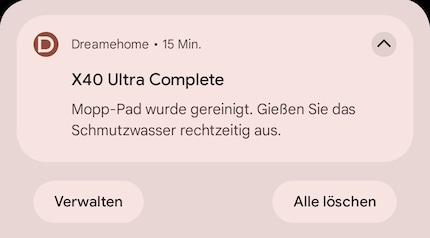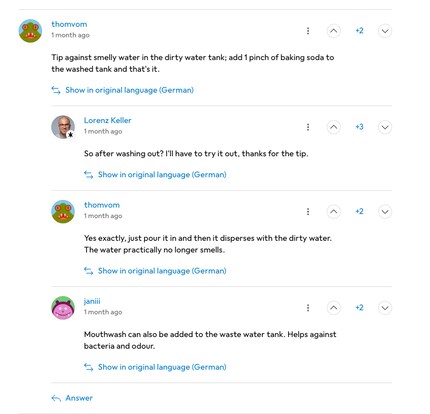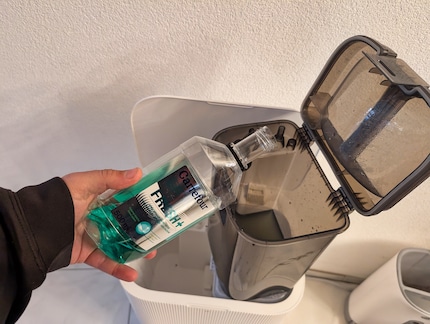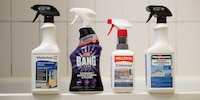
Guide
Four anti-mould agents in comparison
by Simon Balissat
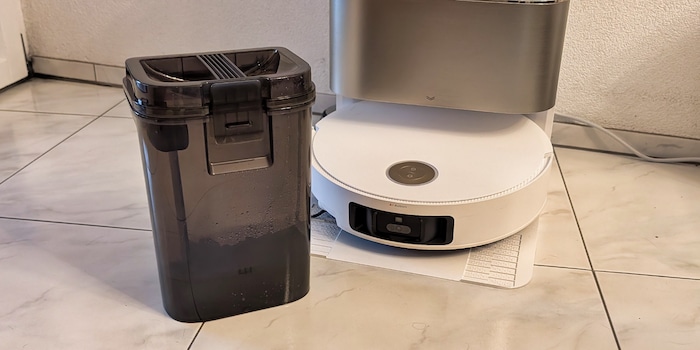
Anyone who owns a robot hoover will be familiar with the problem: your home’s nice and clean, but the waste water tank on your vacuum cleaner smells awful. Thankfully, the Community has recommended two home remedies to combat this odour. I tested both – to astonishing success.
Manufacturers of robot vacuum cleaners promise a week of cleaning without lifting a finger. Just one base station with its fresh water tank, waste water tank and dust bag can automatically empty the dirtbag, refill water and clean and dry the mops. All autonomous.
In theory, I’d only have to top up the water every seven or ten days. In practice, however, I have to tinker with the base station several times a week. Turns out the dirty water produced when washing out mops starts to smell a bit after just one day. If I forget to empty the container, it’ll smell so bad after three or four days that I almost throw up when I wash it out.
I’ve always warned about this in my reviews so far – and manufacturers such as Dreame have already included this in their system, reminding users to empty the waste water tank regularly. Here’s my review of the Dreame X40 Ultra Complete, in which this is mentioned at the beginning.
Is there really no other solution? Apparently, there is. Community members «thomvom» and «janiii» provide two tips on how to prevent a robot vacuum from smelling.
Just add baking soda or mouthwash to the tank – and that’s it? I have to try this!
Fortunately, there’s still some baking soda in my pantry. However, you’ll also find cheaper types in our cleaning section. This article by fellow editor Livia tells you everything else you can do with baking soda at home.
I pour a quarter teaspoon of baking soda powder into the clean tank and let the robot do its work. After that, I deliberately leave the dirty water in and take a whiff every day.
So, baking soda really does work. Instead of having to empty the waste water after two days at the latest, I only do it every five. If necessary, I can let the robot clean over a week-long vacation without looking after it. Without the baking soda, the smell would leak out of the sealed container – cleaning the thing would be a nightmare.
The second suggestion seems almost crazier. Instead of baking soda, I tip a sip of mouthwash into the waste-water tank.
Again, I sniff the waste water day after day. This is much more pleasant at first since it emits a slight peppermint note, lasting until day four. That’s when less pleasant odours start to mix in, prompting me to empty the tank and wash it out.
Mouthwash also works, but it’s somewhat less effective than baking soda in the long run. On the other hand, the smell is more pleasant initially and doesn’t simply neutralise like the powder.
These two tips already bring me very close to the promised one week of complete automation. Nevertheless, I won’t be using baking soda or mouthwash all year-round, but rather on a situational basis when I’m away. For me, the risk of forgetting to use it once and then having to clean the smelly container a week later is too great all year-round.
Got any other tips on how to make your robot vacuum cleaner easier to clean? Put them in the comments!
Gadgets are my passion - whether you need them for the home office, for the household, for sport and pleasure or for the smart home. Or, of course, for the big hobby next to the family, namely fishing.
Practical solutions for everyday problems with technology, household hacks and much more.
Show all